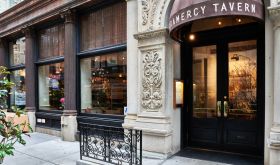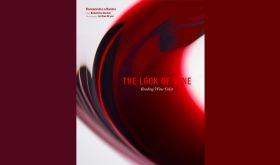The name on the outside of the restaurant is male as is that on the menu, the business card and the bill. The dessert menu even carries a photo of Gordon Ramsay hard at work at the stoves, although I was told he had been at Restaurant Gordon Ramsay in Chelsea, London SW3, only a couple of times this year and then to eat.
But the stars on the night we ate there, despite the fact that the vast majority of the 12 staff in the restaurant and the 15 in the kitchen are also male, were two young women: Clare Smyth, now the chef and a partner in the business, and the sommelier Anna Botting. Both also share an unlikely route to their respective positions.
Smyth (on the right, photographed just last month by John Carey) is from Co Antrim, N Ireland, which she left aged 16 to come to catering college in England before settling in this kitchen in 2002 and working her way up the greasy pole. Botting, whose husband is English, was born in a small village on the Polish coast before stints on luxury yachts around the Mediterranean eventually brought her to London. Smyth and Botting are united by a love of food and wine respectively, enthusiasm enhanced by the fact that their stage is the most intimate dining room.
There are only 14 tables in what has been the crown jewel in Ramsay’s empire since 1998 but was before that the original La Tante Claire. Space is at a premium and as I watched a phalanx of eight waiters approach the tables next to us to serve the main courses to a table of four and seat a table of two, I realised why all the waiting staff including Jean-Claude Breton, its long-serving maître d’, are slim. This intimacy brings three novel benefits.
The first is that the inevitable proximity leads the waiting staff to engage in an unusually friendly manner with their customers. There is no trace here of the ‘de haut en bas’ approach so common in restaurants with three Michelin stars, a way of working which I am sure is enhanced by the team spirit engendered by the fact that the brigade works together lunch and dinner Monday-Friday with only the weekend off.
The second is that Smyth has to fulfil the role not just of chef but also of editor, writing three menus that are tight yet expressive and perforce, logistically easy to deliver. There is no room for carving trolleys and the heavily laden cheese trolley that seems to cause a traffic jam every time it is taken for a spin. Alongside two more expansive tasting menus, Smyth's £95 à la carte menu features only six first courses (of which two revolve around foie gras) and six main courses, of which half are fish.
The arrival of a thick wine list made us realise that as the sommeliers must spend hours not just at the many weekly professional wine tastings across London but also in the kitchen alongside Smyth and her team, testing their particularly eclectic selection of wines by the glass was the most appropriate route. Enter Botting in the absence of her boss, Jan Konetzki, off studying for the rigorous Master Sommelier examination.
No sooner had we explained our menu choices, than back came Botting’s wine recommendations. We had, perhaps subconsciously because we had not eaten here for several years, chosen two of the restaurant’s longest standing first courses, the pressed foie gras with green apples and turnips, and the raviolo of lobster and langoustine poached in a light bisque, the cream colour of the thin pasta encasing the pale pink of the shellfish offset by a deep green sorrel veloute.
With the former, Botting recommended a 2009 Vouvray from Clos Naudin, chosen for its foie gras-friendly combination of richness and crispness. She chose a 2012 Condrieu ‘Les Vallins’ from Domaine Blanc Christophe for its aroma of white peaches with the shellfish. But her other three wines came from outside France. A Schäfer-Fröhlich 2010 Felseneck Nahe dry Riesling with the turbot; a full-bodied 2012 ‘El Tamboril’ white from Spain's Gredos mountains based on the re-evaluated Grenache Gris grape with the halibut; and, finally, a glass of Barbeito Rainwater Madeira that we shared over Smyth’s signature dessert of a lemonade parfait with honey, bergamot and sheep’s milk yoghurt sorbet and a delicate peppermint soufflé with a teaspoon of bitter chocolate sorbet. All these choices were impressive and under £20 a glass each.
However good the wines, it was the finesse of the execution of the dishes that was most impressive. The peppery topping on the foie gras; the gleaming flesh of the turbot, first presented inside the clear parchment it had been baked in then served off the bone alongside charred spring cabbage; the colours and zing of the herbs Smyth incorporates alongside rose petals for her own ‘ras el hanout’ broth that brought out the very best flavours of the Hebridean halibut. And, perhaps most satisfyingly, the conscious omission of carbohydrates that, Smyth explained, is intended to ensure her customers leave delighted but not bloated.
This was definitely how we felt as wandered back to Sloane Square past the incongruous juxtaposition of a desolate Tesco Metro so close to the magnificent Royal Hospital Chelsea.
Restaurant Gordon Ramsay, 68 Royal Hospital Road, London SW3 4HP; tel +44 (0)20 7352 4441














